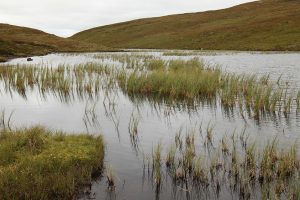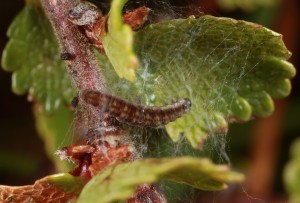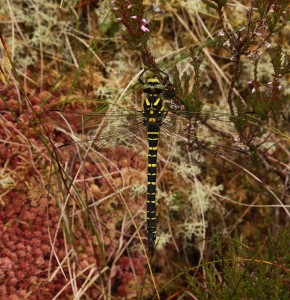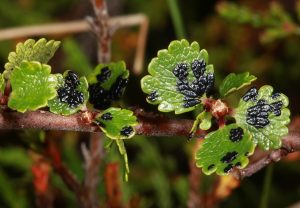
On Sunday 31st July I spent the day on Dundreggan with Jonathan Willett, who is doing a dragonfly survey of the estate for us this year, and my colleague Colin Hall, who also has a keen interest in dragonflies. We went up to the northwest of the estate, to look for evidence of breeding dragonflies in the lochans, pools and small burns there, and I was also intending to look at the dwarf birch plants growing in that area – we fenced an area for natural regeneration of this key montane scrub species there in 2010.
As it turned out, it wasn’t the best day for dragonfly spotting, as it was cool, overcast and very windy, which meant there were very few insects on the wing (no midges thankfully!), and the only adult dragonfly we saw all day was a male golden-ringed dragonfly (Cordulegaster boltonii) that Colin spotted, perched close to the ground on some heather. While Jonathan and Colin continued searching for dragonfly nymphs in some of the pools, I made my way to the dwarf birch exclosure, where I was keen to see how the plants were growing in the absence of grazing pressure from deer.
It took a while to find some of the dwarf birches, as they occur close to the ground, and, after one season’s protected growth, haven’t grown much higher than the surrounding vegetation. Once I got my eye in though I was soon spotting them, and after a few minutes I saw one with some black fungal spots on its leaves. Jane Bowman, near neighbour to Dundreggan and a keen naturalist who spends a lot of time on the estate, had found the same thing on Dundreggan last year, and had got a tentative identification for the species as being a tar spot fungus (Atopospora betulina), but had been unable to get that confirmed. There are apparently very few records for that species in Scotland, but, intriguingly, 3 of them are from dwarf birch! I took a sample and sent it to Liz Holden, a mycologist who has done some fungal surveys for us on Dundreggan. She gave the same tentative ID, but was also unable to confirm it, because of the absence of mature spores. We may have to collect another sample in September, when there should be spores, to pin down the species identity.

Leaving the dwarf birch exclosure, I caught up with Jonathan and Colin, and looked at some dragonfly nymphs they had found, including one of the four-spotted chaser (Libellula quadrimaculata), before wandering off again to locate an isolated eared willow (Salix aurita) I had spotted last year. While doing that, I came across some more dwarf birch plants, and my eye was drawn to some movement on one of them. It was a very small caterpillar, which excited me as I suspected it was of a micro-moth (Swammerdamia passerella), a rare species that is associated with dwarf birch and that features on the Scottish Biodiversity List as a priority for conservation. That species had been found on Dundreggan during a dwarf birch survey carried out for us by Mark Richards in 2008, but we didn’t have any photographs of it. I was delighted to subsequently confirm the identity of the caterpillar, which is notable for spinning an open ‘web’ of silk on the leaves of dwarf birch, within which it feeds – the strands of the web are visible in the photograph here.
Although it wasn’t a spectacularly successful day in terms of the dragonfly survey, I nonetheless returned home very satisfied, having collecting some interesting new records of the biodiversity in the northwest of the estate.


Hi,
For the past two weeks a pair of dragonfly’s have returned to my garden and rested on some ornamental birch stands I have inserted in flower pots for climbing plants.They return almost daily perched on the very top of the wig wam shaped top of these stands for long periods of time We live very near a pond where I suspect they come from.Absolutely fascinating !!